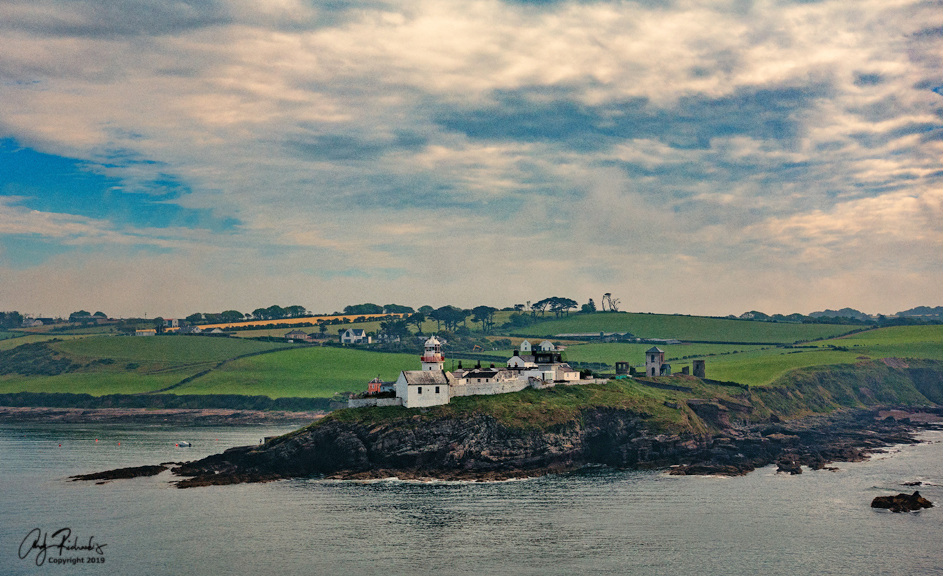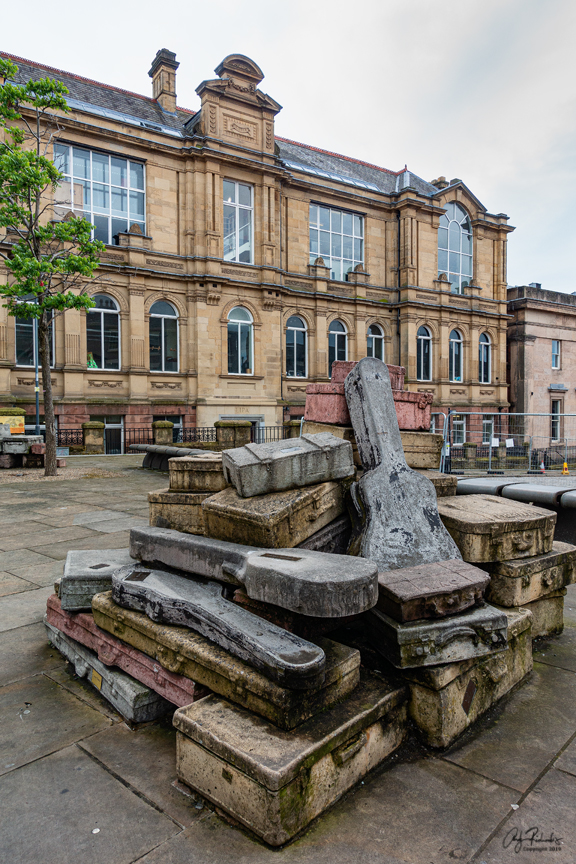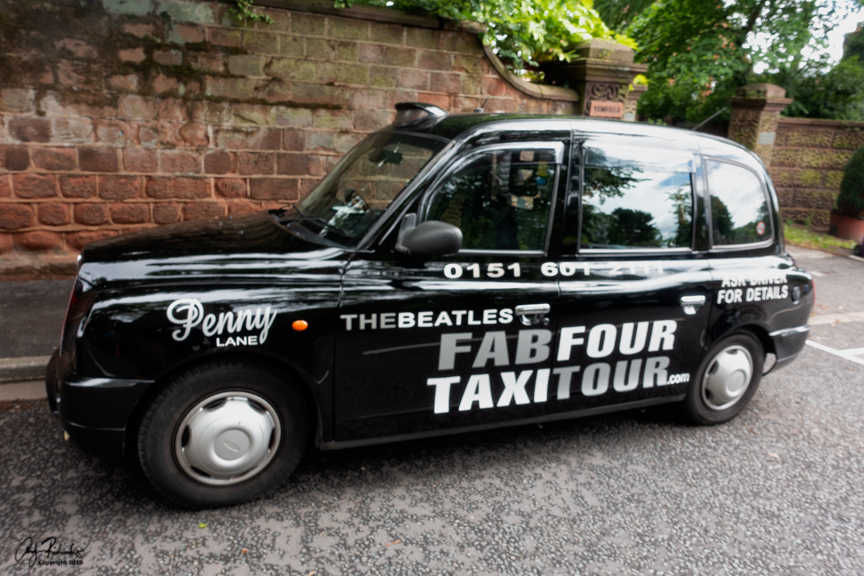[My previous post ended with our stop in Belfast, and it reminded me of the most moving part of that day; our guide's personal experience and description of life in Belfast during a period known in Ireland as "The Troubles." I wanted to give that some time - and some historical context here. What follows is a very shallow dive into Irish history. I will probably have some of it wrong. I would be glad to be corrected and/or educated further. But I hope this post gives at least some feel and color for those stops in our time in Northern Ireland]
WE WILL make our second stop in Belfast during our "Iceland-Ireland" Cruise on the Celebrity Apex in June 2023. In 2019, on our Celebrity Reflection British Isles Cruise, we stopped in Belfast for a day. We learned a lot of history during that trip. I thought since we cover it in at least two cruise blogs here, it might be worthwhile to try to do a short history of the development of the two very separate nations, on the Irish Isle. If you visit Ireland, you will find "not much love for the Brits," though they show us "Americans" a lot of love. In Northern Ireland, they consider themselves "Brits" and an important part of the U.K.
MUCH LIKE the other "British Isles," France, Austria, Germany and other parts of "mainland" Europe, we know that today's Irish population descends from Celtic people who at some point migrated onto the island. Historians believe that at some point thousands of years back, there were land bridges between these now-islands. We also know that the Romans were in England, but there is some doubt that they ever made it to Ireland.
THE IRISH Patron Saint is, of course, St. Patrick. Thought by most historians to have arrived in Ireland in the early part of the First Century (around 432 A.D.), he is widely credited with having first brought Christianity to Ireland. Near that same time, the Pope sent Palladius to Ireland as its first Bishop. At that time, of course, essentially all of Christendom was Catholic. It would not be for more than 1000 years hence that there would even be the concept of Protestantism. But this dichotomy would eventually have significant and severe consequences for Ireland. The history of Christianity in Ireland is burdened with a fair amount of debate, doubt and unknown. Popular culture has credited St. Patrick with bringing the Roman alphabet to Ireland, and to have codified much of Irish law. Historians debate this and most of this lore - which has become "the myth of Patrick" among historians, was developed well after his death. Whatever the truth is, Ireland became an important center of Christianity in the Middle Ages, with Latin Scholars and Missionaries from its monasteries spreading the idea of scholarship and learning into England and Continental Europe. Scholars from other nations came to these Irish Monasteries, which produced such notable art and manuscripts as the famed “Book of Kells,” now housed at Trinity College in Dublin.
AT THE end of the 8th Century, the Vikings from Norway attacked and looted the Island. These raiders sadly looted many of the monasteries, as well as towns along their path. The Vikings established settlements in ports like Cork, Limerick, Waterford, Wexford, and - most notably – Dublin. There were armed conflicts between the Irish and Vikings over the next 200 or so years. Eventually, in the Battle of Clontarf, probably the most famous “High King of Ireland,” Brian Boru, defeated the Vikings marking the beginning of the decline of their influence.
As a (perhaps) interesting aside, I have mentioned the O'brien Estate Winery here on a number of occasions. Most prominently, they were the reason behind our first Celebrity Cruise and subsequent strong allegiance to the Celebrity Cruise Lines. Shortly after that cruise, they announced a trip to Ireland. Following the Battle of Clontarf (in which Boru was actually killed), his descendants became known as O' Briain (today O'Brien) and provided at least 3 more High Kings of Ireland. Originally of the noble House of Munster, Brian Boru, became the first High King of Ireland through a series of conquests of other noble houses. It is generally thought that anyone with the name O'Brien, is progeny of Brian Boru, the proprietor of Obrien Estate Vineyard included. Bart O'Brien took his ancestry seriously enough that he became a member of Ireland's Brian Boru Society, eventually ascending to the board, and eventually becoming board chair. During this period, he arranged a "Life of Brian" tour for patrons of the winery, and we joined them for a fun-filled, and informative trek from Dublin, to Galway, to Limerick to Kilkenny to and back to Dublin, where we stayed in the Clontarf Castle. Along the way we visited Boru's birthplace and the place of some of his battles, and eventually, his final resting place in St. Patrick's Church of Ireland Cathedral in Armagh, Northern Ireland.
THE VIKINGS not only established the seaports above, all of which became major cities of Ireland, but they introduced their sophisticated trading and commerce systems which became part of Irish society. After their decline in power, though many of them had permanently settled there, Ireland was largely composed of a hodgepodge of separate kingdoms. The High King considered himself king over all of Ireland, but in reality, disputes and warfare among the various kingdoms continued. At the end of the century, the Normans from England invaded the south of Ireland, beginning in Waterford. With the support of the Vatican, they eventually conquered and "controlled" all of Ireland, though fighting and tensions continued through the years. But by the middle of the 14th century, the Black Plague (or Black Death) struck. It ravaged the cities. Most of the English were living in the cities (along with Irishmen). But most of the rural locations were Irish populated, and the Irish language and culture once again began to dominate. By the end of the 15th Century, English domination and control had severely declined. England, at the time, was occupied by continued war with France ("100 Years War") and later fighting among different noble houses over control of the English throne ("Wars of the Roses").
IN 1536, having established the House of Tudor as the clear ruling family of England's monarchy, the English determined (under Henry VIII) to re-establish control of Ireland and once again, invaded. Successfully in control, they granted the status of full Kingdom to Ireland (but of course, under the control of England and Parliament, who named Henry the "King of Ireland"). It took nearly 100 years afterward until England was firmly in control in Dublin.
WHICH BRINGS us (albeit in a roundabout way) to the original direction of this post. A period in Irish history of nearly 40 years (1960-ish to 1998), euphemistically known as "The Troubles." The more parochial among us Americans may not realize that there was more than one "Civil War." Fortunately for our own history, we have had only one. Hence, we refer to our own civil war as "The Civil War." The troubles were most certainly "civil war." It is common for citizens of the U.S. to think the American Civil War was very simply about slavery. It is also a common belief around the world, that The Troubles were simply a dispute between Protestant and Catholic religious factions. Both thoughts could not be more of an oversimplification. We will leave the American Civil War to another discussion on another day. But before boiling down the causes of The Troubles, we really need to go back in history further than 1960. Much further. All the way back to the 17th Century. And there, we will learn (as is true of much of the world's history) that the cause was as much political as it was religious. And perhaps we will conclude that in spite of some strong efforts to separate church and state in many cases, that history and religion are hopelessly intertwined throughout the years. Indeed, not only are there strong religious factions in governments throughout history, but there are also major struggles between government and religious establishment for power.
INTEGRAL IN their ascension to control over Ireland was England's own brand of Protestant religion. A large part of their establishment of control involved the disposition of formerly powerful, and near-universally Catholic, Irish landowners and noblemen, further blurring the distinction between religion and political power. Warfare between the Irish (Catholic) and the British (mostly Protestant) continued for 100s of years. But the fighting was really not about religious dogma (though dogma was certainly involved). It was about power, control and resentment. Perhaps at times in the name of religion. But to say it was a Catholic - Protestant dispute would a mischaracterization and oversimplification.
IRISH PRISONERS from these wars, and eventually Irish (Catholic) landowners and peasants were shipped from Ireland into slavery (though they called it "indentured servitude," imposed to in the Caribbean (particularly Barbados). England ruled over their conquests with a heavy hand, and the British Crown arrogantly insisted that all within its power observe their (Protestant) religion in all things. Fighting and resistance to this authority continued on and off through several hundred years. Over this period, the land was increasingly owned by (Protestant) English owners or Irish - with English affiliation/sympathy - owners and leased to mostly poor Irish (Catholic) tenant farmers. This further aggravated the tensions. To that was added the famine of 1848 (sometimes known as "The Potato Famine"), which reduced the Irish population by nearly 45% and which obviously mostly affected the Irish poor tenant families (Catholic).
WHILE IRELAND did have "representation" in Parliament, it was mostly diluted. There was legislation offered to try to ameliorate the conditions in Ireland, but it was mostly unsuccessful. Likewise, measures to grant home rule (a precursor to Irish Independence) in the early 20th Century were mainly thwarted by negative votes in Parliament (perhaps aggravated by their preoccupation at times, with the First World War). By this time, factions inside Ireland had developed. A Nationalist (Catholic) group wanted Irish independence and a smaller Loyalist (Protestant) group wanted to maintain ties with the United Kingdom. They split out in roughly geographical lines, with most of the loyalists living in the northern part of the country, central to Belfast. The Nationalists occupied a much larger geographical area, with its political center in Dublin. Much of this occurred while World War I was in full swing. Following the war, relations between England and the Nationalists continued to deteriorate and even toward the end of the war, there was open rebellion in Dublin (The Easter Rising). The rebels' political party, Sinn Fein won a majority of the Irish Parliament and their newly formed Irish Republican Army (IRA) declared Ireland to now be The Republic of Ireland. After 3 more years of guerilla rebellion by the IRA against England, the governments negotiated a treaty in which Ireland was allowed to be a "Free State," and would be separated into Northern Ireland and Southern Ireland and Northern Ireland would be allowed to opt out of the "Free State" and remain a part of the U.K. Northern Ireland soon opted out of the "Free State." Over the next year, two factions within the Nationalist party (treaty supporters and anti-treaty non-supporters) fought a bloody battle between themselves: The Irish Civil War (1922 - 1923). The Treaty supporters eventually won, but not without leaving a significant rift in the nationalist ranks, which continues today.
NORTHERN IRELAND was dominated by a Unionist government, which declared that Northern Ireland would be a "Protestant State for Protestant People." Catholics were discriminated against in a number of ways, excluded from jobs, better housing and political participation. This led to a kind of "civil rights" movement by them in the 1970's, which turned to violence - primarily between Catholic backed and Protestant backed groups. The Troubles fully started when a peaceful demonstration in Derry in Northern Ireland turned violent, when governmental policy brutally beat protesters; an even which made national news. In the ensuing months more violence erupted and British Troops were sent to maintain the peace. The insertion of British Troops perhaps only exacerbated tensions. In 1972, on "Bloody Sunday," they opened fire on protesters - again in Derry - killing 13 unarmed civilians. The violence continued to escalate, and at times, extended south into The Irish Republic (which by then had renamed itself, simply, "Ireland"), and even into England and occasionally parts of continental Europe (On 7 February 1991, the IRA unsuccessfully attempted to assassinate English prime minister John Major and his war cabinet by launching a mortar at 10 Downing Street while they were gathered there to discuss the Gulf War). Tensions between the factions were violent and often bloody. Cities like Belfast divided into geographical sections and "Peace Walls" were erected (and closed during the nights for many years) between the different sections of the city.
REMEMBER THAT Northern Ireland was not at that time a separate republic. The British response to "The Troubles" was to put Northern Ireland under "Direct Rule" (rather than "home rule"). The violence and conflict continued between Nationalist and Unionist, Protestant and Catholic, and Ireland and the U.K. for a period of years, involving an "alphabet soup," of military organizations, including the IRA, RUC (Royal Ulster Constabulary), INLA (Irish National Liberation Army), Provisional Irish Republican Army, Ulster Defence Regiment, Ulster Volunteer Force and the British Army. While "The Troubles" are usually deemed to have ended with the "Good Friday Agreement" of April 10, 1998 (perhaps the first true thawing of relations between the factions in country), it wasn't until 2005, that the IRA finally announced its cessation of armed conflict, and real peace began to become possible.
despite use of the terms Protestant and Catholic to refer to the sides, it was not simply a religious conflict
HOPEFULLY, IT can be seen from the above that despite use of the terms Protestant and Catholic to refer to the sides, it was not simply a religious conflict. Perhaps the key issue was the status of Northern Ireland. Unionists and loyalists, who for historical reasons were mostly Ulster Protestants, wanted Northern Ireland to remain within the United Kingdom. Irish nationalists and republicans, who were mostly Irish Catholics, wanted Northern Ireland to leave the United Kingdom and join a united Ireland.
IT IS into this backdrop that we have visited Northern Ireland - now twice. Our first trip was with the O'Brien Group in 2014. It was both notable and scary that as we crossed the border. We observed a major military/police presence at most public buildings. The police stations were barricaded and patrolled by heavily armed officers who look much more military than you generally see as police presence. In 2020, we landed in Belfast on our cruise ship, Celebrity Reflection for a day. While most of our time was spent up in the northern part of the country, we drove through Belfast, and our guide was a young man who had grown up right smack in the middle of "The Troubles." He had some stories.
WHILE WE it seemed that the police presence we had sensed and seen 6 years prior was no longer there. We learned that only in that 6-years, had tensions begun to lessen. Unfortunately, like the rest of the world, sectarianism, prejudice and even bigotry still lurks. Two of the phenomena that underscore that are the continued existence of the "Peace Walls," and the phenomena of the "Eleventh Night Bonfires." The bonfires date back to the late seventeenth century Glorious Revolution, which marked the removal and exile of King James (Stuart) and the elevation of Mary, who was the first Protestant ruler, to the throne. There is some thought that the origination of these bonfires was that they were lit on the hills to guide the Williamite ships into the Belfast harbor. This period is thought to have marked the ascendancy of Protestantism to Northern Ireland. Apparently primarily a Protestant Celebration today, the bonfires have often been marred by sectarianism and bigotry (signs attached, effigies, burned, etc.). As we drove through Belfast, we saw the preparations for the fires in the distance. Today, they are built with old pallets and often tower as high as buildings. While there are supposed to be in celebration, we got the impression that they also cause their fair share of problems.
THE PEACE Walls were erected (originally) as temporary structures separating predominately Unionist/Protestant neighborhood and predominately Nationalist/Catholic neighborhoods in some of the areas where most violence occurred. Even after the Good Friday Agreement, these walls continued to be fortified. As high as 25 feet, they became more or less permanent structures, built of lasting materials such as steel and concrete. As of 2017 there were as many as 29 of them in Belfast, most in the northwest part of the city. Unsurprisingly, this area contains working class sections of Belfast. In surveys taken in recent years, many residents favor leaving the walls in place with the fear of future violence. It has become a bit of a tradition for visitors to Belfast to sign some of these walls. The shot below shows my wife and my brother-in-law signing the wall on Shankill Road, on the predominantly Loyalist (Unionist) neighborhood of Shankill.
Signing the Wall - Belfast, Northern Ireland - 2020
IN MAY, we will be in Belfast once again, and I hope to get even more history and insight into this city and the issues of the times. I really thought it would be useful to put our visit there in perspective.




































